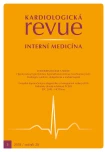Primary aldosteronism and hypertension
Authors:
P. Vysočanová
Authors‘ workplace:
Interní kardiologická klinika LF MU a FN Brno
Published in:
Kardiol Rev Int Med 2018, 20(3): 178-180
Overview
Primary aldosteronism (PA), the most common cause of secondary hypertension, is reported in 4.3% of hypertensive patients. It is caused by the overproduction of aldosterone due to an adrenal disorder. Primary aldosteronism is associated with resistant hypertension, hypokalaemia and increased cardiovascular morbidity. Primary aldosteronism is diagnosed through a multistep procedure, beginning with measurement of the aldosterone-to-renin ratio, a basic screening test. Then confirmatory tests, the collection of blood samples and morphologic imaging need to be performed. A unilateral laparoscopic adrenalectomy for patients with documented unilateral primary aldosteronism is recommended. Medical treatment with a mineralocorticoid receptor (MR) antagonist (spironolactone) is recommended for patients with PA due to a bilateral adrenal disease or patients unwilling or unable to undergo surgery. Early diagnostics and treatment of the PA may resolve hypokalaemia, lower the blood pressure and reverse the cardiovascular morbidity caused by the aldosterone excess.
Key words:
primary aldosteronism – hypertension
Sources
1. Hannemann A, Wallaschofski H. Prevalence of primary aldosteronism in patient's cohorts and in population-based studies--a review of the current literature. Horm Metab Res 2012; 44(3): 157– 162. doi: 10.1055/ s-0031-1295438.
2. Milliez P, Girerd X, Plouin PF et al. Evidence for an increased rate of cardiovascular events in patients with primary aldosteronism. J Am Coll Cardiol 2005; 45(8): 1243– 1248. doi: 10.1016/ j.jacc.2005.01.015.
3. Stowasser M, Sharman J, Leano R et al. Evidence for abnormal left ventricular structure and function in normotensive individuals with familial hyperaldosteronism type I. J Clin Endocrinol Metab 2005; 90(9): 5070– 5076. doi: 10.1210/ jc.2005-0681.
4. Reincke M, Fischer E, Gerum S et al. Observational study mortality in treated primary aldosteronism: the German Conn's registry. Hypertension 2012; 60(3): 618– 624. doi: 10.1161/ HYPERTENSIONAHA.112.197111.
5. Somlóová Z, Widimský J, Rosa J et al. The prevalence of metabolic syndrome and its components in two main types of primary aldosteronism. J Hum Hypertens 2010; 24(10): 625– 630. doi: 10.1038/ jhh.2010.65.
6. Douma S, Petidis K, Doumas M et al. Prevalence of primary hyperaldosteronism in resistant hypertension: a retrospective observational study. Lancet 2008; 371(9628): 1921– 1926. doi: 10.1016/ S0140-6736(08)60834-X.
7. Funder JW, Carey RM, Mantero F et al. The management of primary aldosteronism: case detection, diagnosis, and treatment: an endocrine society clinical practice guideline. J Clin Endocrinol Metab 2016; 101(5): 1889– 1916. doi: 10.1210/ jc.2015-4061.
8. Zelinka T, Ceral J, Widimský J. Jak postupovat při podezření na primární hyperaldosteronismus? Hypertenze & kardiovaskulární prevence 2017; 6(1): 32– 35.
9. Sarlon-Bartoli G, Michel N, Taieb D et al. Adrenal venous sampling is crucial before an adrenalectomy whatever the adrenal-nodule size on computed tomography. J Hypertens 2011; 29(6): 1196– 1202. doi: 10.1097/ HJH.0b013e32834666af.
10. Ghose RP, Hall PM, Bravo EL. Medical management of aldosterone-producing adenomas. Ann Intern Med 1999; 131(2): 105– 108.
11. Parthasarathy HK, Ménard J, White WB et al. A double-blind, randomized study comparing the antihypertensive effect of eplerenone and spironolactone in patients with hypertension and evidence of primary aldosteronism. J Hypertens 2011; 29(5): 980– 990. doi: 10.1097/ HJH.0b013e3283455ca5.
12. Indra T, Holaj R, Štrauch B et al. Long-term effects of adrenalectomy or spironolactone on blood pressure control and regression of left ventricle hypertrophy in patients with primary aldosteronism. J Renin Angiotensin Aldosterone Syst 2015; 16(4): 1109– 1117. doi: 10.1177/ 1470320314549220
Labels
Paediatric cardiology Internal medicine Cardiac surgery CardiologyArticle was published in
Cardiology Review

2018 Issue 3
Most read in this issue
- Perindopril and cardiovascular disease – 25 years of success in cardiology
- Hypothyroidism and the heart
- Gestational diabetes mellitus and possibilities for its treatment
- Commented shortened version of the 2018 ESC Guidelines for the diagnosis and management of syncope
